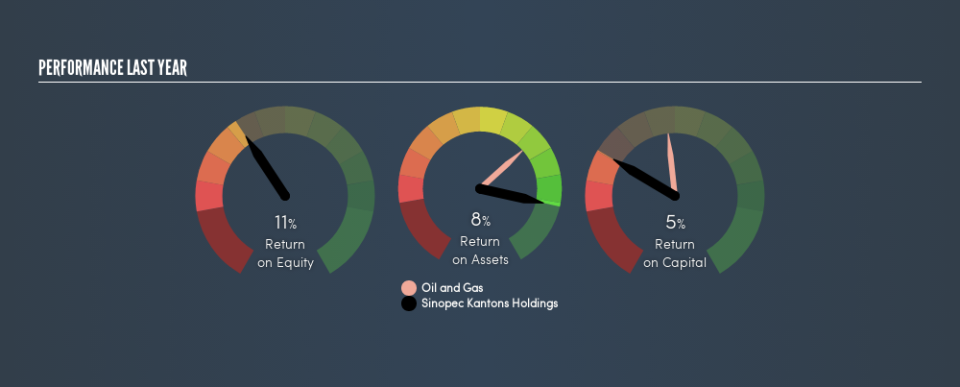Why We’re Not Impressed By Sinopec Kantons Holdings Limited’s (HKG:934) 4.9% ROCE

Today we’ll evaluate Sinopec Kantons Holdings Limited (HKG:934) to determine whether it could have potential as an investment idea. Specifically, we’re going to calculate its Return On Capital Employed (ROCE), in the hopes of getting some insight into the business.
First of all, we’ll work out how to calculate ROCE. Then we’ll compare its ROCE to similar companies. Last but not least, we’ll look at what impact its current liabilities have on its ROCE.
Understanding Return On Capital Employed (ROCE)
ROCE measures the amount of pre-tax profits a company can generate from the capital employed in its business. In general, businesses with a higher ROCE are usually better quality. Ultimately, it is a useful but imperfect metric. Author Edwin Whiting says to be careful when comparing the ROCE of different businesses, since ‘No two businesses are exactly alike.’
So, How Do We Calculate ROCE?
Analysts use this formula to calculate return on capital employed:
Return on Capital Employed = Earnings Before Interest and Tax (EBIT) ÷ (Total Assets – Current Liabilities)
Or for Sinopec Kantons Holdings:
0.049 = HK$585m ÷ (HK$17b – HK$5.0b) (Based on the trailing twelve months to June 2018.)
Therefore, Sinopec Kantons Holdings has an ROCE of 4.9%.
Check out our latest analysis for Sinopec Kantons Holdings
Does Sinopec Kantons Holdings Have A Good ROCE?
ROCE is commonly used for comparing the performance of similar businesses. We can see Sinopec Kantons Holdings’s ROCE is meaningfully below the Oil and Gas industry average of 9.9%. This performance is not ideal, as it suggests the company may not be deploying its capital as effectively as some competitors. Independently of how Sinopec Kantons Holdings compares to its industry, its ROCE in absolute terms is low; especially compared to the ~2.0% available in government bonds. Readers may wish to look for more rewarding investments.
As we can see, Sinopec Kantons Holdings currently has an ROCE of 4.9%, less than the 11% it reported 3 years ago. This makes us wonder if the business is facing new challenges.
When considering ROCE, bear in mind that it reflects the past and does not necessarily predict the future. ROCE can be misleading for companies in cyclical industries, with returns looking impressive during the boom times, but very weak during the busts. This is because ROCE only looks at one year, instead of considering returns across a whole cycle. Remember that most companies like Sinopec Kantons Holdings are cyclical businesses. Future performance is what matters, and you can see analyst predictions in our free report on analyst forecasts for the company.
What Are Current Liabilities, And How Do They Affect Sinopec Kantons Holdings’s ROCE?
Current liabilities are short term bills and invoices that need to be paid in 12 months or less. The ROCE equation subtracts current liabilities from capital employed, so a company with a lot of current liabilities appears to have less capital employed, and a higher ROCE than otherwise. To check the impact of this, we calculate if a company has high current liabilities relative to its total assets.
Sinopec Kantons Holdings has total assets of HK$17b and current liabilities of HK$5.0b. As a result, its current liabilities are equal to approximately 29% of its total assets. This is a modest level of current liabilities, which will have a limited impact on the ROCE.
What We Can Learn From Sinopec Kantons Holdings’s ROCE
That’s not a bad thing, however Sinopec Kantons Holdings has a weak ROCE and may not be an attractive investment. You might be able to find a better buy than Sinopec Kantons Holdings. If you want a selection of possible winners, check out this free list of interesting companies that trade on a P/E below 20 (but have proven they can grow earnings).
For those who like to find winning investments this free list of growing companies with recent insider purchasing, could be just the ticket.
We aim to bring you long-term focused research analysis driven by fundamental data. Note that our analysis may not factor in the latest price-sensitive company announcements or qualitative material.
If you spot an error that warrants correction, please contact the editor at editorial-team@simplywallst.com. This article by Simply Wall St is general in nature. It does not constitute a recommendation to buy or sell any stock, and does not take account of your objectives, or your financial situation. Simply Wall St has no position in the stocks mentioned. Thank you for reading.

